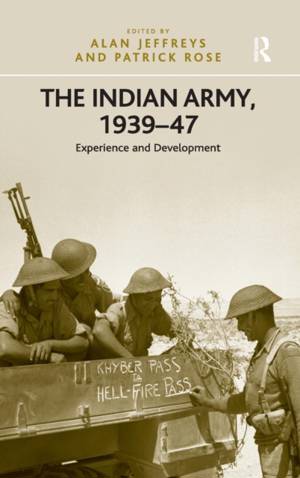
- Afhalen na 1 uur in een winkel met voorraad
- Gratis thuislevering in België vanaf € 30
- Ruim aanbod met 7 miljoen producten
- Afhalen na 1 uur in een winkel met voorraad
- Gratis thuislevering in België vanaf € 30
- Ruim aanbod met 7 miljoen producten
Zoeken
€ 320,95
+ 641 punten
Uitvoering
Omschrijving
The sheer size and influence of the British Indian Army, and its major role in the Allied War effort between 1939 and 1945 on behalf of a country from which it was seeking independence, maintains its fascination as a subject for a wide variety of historians. This volume presents a range of papers examining the Indian Army experience from the outbreak of world war in 1939 to the partition of India in 1947. With contributions from many of those at the forefront of the study of the Indian Army and Commonwealth history, the book focuses upon a period of Indian Army history not well covered by modern scholarship. As such it makes a substantial contribution across a range of subject areas, presenting a compendium of chapters examining Indian Army participation in the Second World War from North Africa to Burma, plus a variety of other topics including the evolution of wartime training, frontier operations, Churchill and the Indian Army, the Army's role in the development of post-war British counterinsurgency practice, and of particular note, several chapters examining aspects of the partition in 1947. As such, the book offers a fascinating insight into one of the most important yet least understood military forces of the twentieth century. It will be of interest not only to those seeking a fuller understanding of past campaigns, but also to those wishing to better understand the development and ethos of the present day military forces of the Indian subcontinent.
Specificaties
Betrokkenen
- Auteur(s):
- Uitgeverij:
Inhoud
- Aantal bladzijden:
- 256
- Taal:
- Engels
Eigenschappen
- Productcode (EAN):
- 9781409435532
- Verschijningsdatum:
- 28/06/2012
- Uitvoering:
- Hardcover
- Formaat:
- Genaaid
- Afmetingen:
- 156 mm x 234 mm
- Gewicht:
- 539 g

Alleen bij Standaard Boekhandel
+ 641 punten op je klantenkaart van Standaard Boekhandel
Beoordelingen
We publiceren alleen reviews die voldoen aan de voorwaarden voor reviews. Bekijk onze voorwaarden voor reviews.








